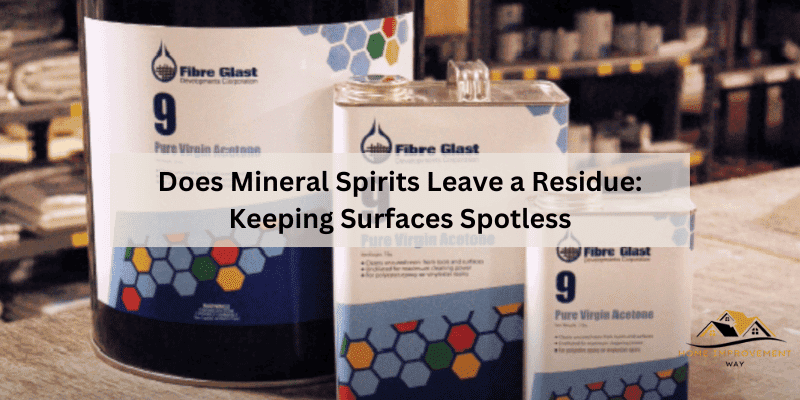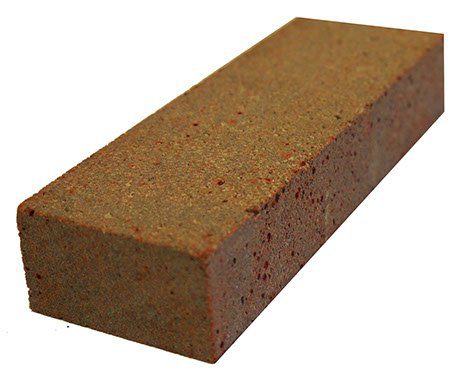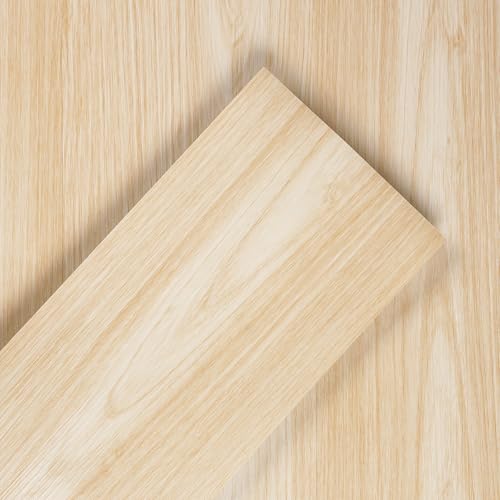Does Mineral Spirits Leave a Residue: Keeping Surfaces Spotless
Yes, mineral spirits can leave a residue if not properly wiped away. When using mineral spirits, it is essential to thoroughly clean and wipe the surface to prevent any residue from being left behind.
Residue can occur if the mineral spirits are not completely evaporated or if they are not properly removed. This residue can affect the adhesion and finish of any subsequent coatings or finishes applied to the surface. It is important to follow proper cleaning procedures to ensure a residue-free surface when using mineral spirits for cleaning or thinning.
Mineral spirits, commonly used as a solvent for cleaning and thinning paint, is known for its effective degreasing properties. However, if not used correctly, it can leave behind a thin film or residue on surfaces. Understanding how to properly apply and clean with mineral spirits can help maintain a clean and residue-free work environment.
Understanding Mineral Spirits And Its Residue
Mineral spirits, also known as white spirit or mineral turpentine, is a widely used solvent for cleaning and degreasing surfaces. It is commonly employed in various industries and households due to its effectiveness in removing greasy residues, paint, and stubborn stains. However, there is a common concern regarding whether mineral spirits leave a residue after cleaning.
Mineral spirits are derived from petroleum and are a mixture of aliphatic, aromatic, and cycloaliphatic hydrocarbons. They are clear, colorless, and have a mild odor. The chemical composition of mineral spirits contributes to its ability to dissolve oils, greases, and other contaminants from surfaces without causing damage.
When applied to a surface, mineral spirits work by breaking down and dissolving greasy residues, paints, and varnishes. It acts as a powerful degreaser and cleaner, effectively removing contaminants from metal, wood, and other surfaces.
Mineral spirits evaporate quickly, leaving a clean and dry surface. This makes it an ideal choice for pre-painting surface preparation, as it ensures the removal of any residual solvent that could affect the adhesion and finish of the paint.
- Mineral spirits are generally considered to leave minimal to no residue when used as a cleaning agent.
- However, the potential for residue can depend on various factors such as the type of surface being cleaned, the amount of mineral spirits used, and the efficacy of the cleaning process.
- It is essential to ensure thorough drying post-cleaning to minimize any potential residue.
Identifying Residue On Surfaces
Identifying residue on surfaces is an important step in understanding the effectiveness of cleaning agents and solvents such as mineral spirits. Residue left behind by mineral spirits can impact the quality of the finished surface, making it essential to be able to identify and address any potential residue. In this section, we will explore the visual indications, tactile detection, and the use of testing kits to identify residue left by mineral spirits.
Visual Indications Of Residue
Visual indications of residue left by mineral spirits can often be observed through a hazy or cloudy appearance on the surface. Streaks or smudges may also be visible, especially under direct lighting. Another visual indication is the presence of dull or splotchy areas, which can signal the presence of residue.
Tactile Detection Of Residue
When assessing residue left by mineral spirits, tactile detection can be utilized. Tacky or sticky sensations when running a hand across the surface can indicate the presence of residue. Additionally, uneven or rough texture may also be felt, signaling that residue is present on the surface.
Using Testing Kits To Identify Residue
Testing kits specifically designed to identify residue can be used to accurately determine the presence of residue left by mineral spirits. These kits often utilize chemical indicators that react to the presence of residue, providing a clear indication of its presence and extent.
Effective Cleaning Methods
When it comes to utilizing mineral spirits for cleaning, it’s essential to understand the effectiveness of cleaning methods to ensure a residue-free result. Proper cleaning techniques, the right cleaning agents, and safe environmental practices are crucial factors to consider for achieving optimal cleaning outcomes.
Utilizing Proper Cleaning Techniques
Utilizing the right cleaning techniques is crucial in ensuring that mineral spirits do not leave any residue. Here are some essential steps to follow for effective cleaning:
- Begin by ventilating the area to allow for proper air circulation.
- Use clean, lint-free cloths or towels for wiping surfaces to prevent leaving behind any fibers or debris.
- Apply the mineral spirits sparingly and evenly across the surface to be cleaned.
- Utilize a gentle, circular motion when wiping to ensure thorough coverage and removal of any contaminants.
- Finally, allow for proper drying time to ensure no residual mineral spirits or moisture is left behind.
Selecting The Right Cleaning Agents
Choosing the appropriate cleaning agents is vital for achieving a residue-free cleaning outcome. When selecting mineral spirits for cleaning, it’s essential to consider the following:
- Opt for high-quality, pure mineral spirits to minimize the risk of leaving behind any residual substances.
- Ensure that the mineral spirits are compatible with the surface to be cleaned to avoid any adverse reactions or potential damage.
- Verify that the mineral spirits are free from impurities or additives that may contribute to residue formation.
- Follow the manufacturer’s recommendations regarding the application and usage of mineral spirits for specific cleaning tasks.
Incorporating Safe And Environmentally Friendly Practices
It’s crucial to incorporate safe and environmentally friendly practices when using mineral spirits for cleaning to minimize any potential residue while prioritizing environmental responsibility. Consider the following sustainable practices:
- Properly dispose of used mineral spirits according to local regulations and guidelines to prevent environmental contamination.
- Consider alternative eco-friendly cleaning agents that are biodegradable and have minimal impact on the environment.
- Utilize reusable cleaning cloths or tools to reduce waste and minimize the use of disposable cleaning materials.
- Minimize the use of mineral spirits by employing effective cleaning techniques to reduce overall consumption and potential residue formation.
Preventive Measures
When working with mineral spirits, it’s essential to take preventive measures to minimize residue build-up and maintain spotless surfaces. By implementing the following tips and using alternative cleaning solutions, you can effectively prevent the lingering residue that mineral spirits may leave behind.
How To Minimize Residue Build-up
Preventing residue build-up when using mineral spirits involves proper application and cleanup techniques. Ensure that you are using the appropriate amount of mineral spirits and that excess solvent is not left on the surface. Always follow these steps:
- Use a clean, lint-free cloth to apply the mineral spirits to the surface.
- Wipe the surface in a single direction to avoid spreading the residue.
- After cleaning, use a separate clean cloth to dry and buff the surface.
Tips For Maintaining Spotless Surfaces
After using mineral spirits, it’s crucial to implement proper maintenance practices to keep surfaces spotless. Consider the following tips:
- Regularly inspect the cleaned surfaces for any residue or streaks.
- Address any residue promptly by re-cleaning the affected area with a fresh cloth and mineral spirits.
- Utilize a gentle, non-abrasive cleaner for routine maintenance to prevent residue accumulation over time.
Using Alternative Cleaning Solutions
When looking for alternatives to mineral spirits, consider using eco-friendly solvent-free cleaners or natural cleaning solutions. These alternatives can effectively clean surfaces while minimizing residue build-up. Options include:
| Cleaning Solution | Benefits |
|---|---|
| Vinegar and Water Solution | Non-toxic, effective on glass and mirrors |
| Lemon Juice and Baking Soda | Natural deodorizer and degreaser |
| Rubbing Alcohol | Evaporates quickly, ideal for electronic devices |
Health And Environmental Impact
Mineral spirits are commonly used as a solvent in various industries, including painting, cleaning, and degreasing. While they can effectively dissolve and remove grease, oil, and paint, one concern that arises is whether mineral spirits leave a residue that could have potential health and environmental impacts.

Potential Hazards Of Residue Exposure
When mineral spirits evaporate, they can leave behind a residue that may contain harmful chemicals such as hydrocarbons and volatile organic compounds (VOCs). Prolonged exposure to these residues can lead to respiratory issues, skin irritation, and other health hazards. Additionally, the release of VOCs into the atmosphere contributes to air pollution and poses environmental risks.
Ensuring Safe Handling Of Mineral Spirits
To minimize the risks associated with residue exposure, it’s essential to handle mineral spirits safely. This includes using them in well-ventilated areas, wearing protective gear such as gloves and masks, and promptly disposing of used mineral spirits in accordance with regulations to prevent environmental contamination.
Eco-friendly Alternatives To Mineral Spirits
Fortunately, there are eco-friendly alternatives to mineral spirits that offer effective cleaning and degreasing properties without leaving harmful residues. These alternatives include citrus-based solvents, soy-based cleaners, and water-based substitutes. By choosing these greener options, you can reduce the impact on both human health and the environment.
Regulatory Compliance
Regulatory compliance is a crucial aspect of managing mineral spirits and ensuring the safety and well-being of both the environment and individuals. Understanding and adhering to regulatory guidelines, compliance with safety standards, and ethical considerations of residue management are essential components of regulatory compliance in the use of mineral spirits.
Understanding Regulatory Guidelines
Regulatory guidelines set forth by organizations such as the Occupational Safety and Health Administration (OSHA) and the Environmental Protection Agency (EPA) outline the safe handling, storage, and disposal of mineral spirits. It is important to familiarize oneself with these regulations to maintain compliance and minimize environmental impact.
Compliance With Safety Standards
Compliance with safety standards involves implementing proper measures to prevent and mitigate the release of mineral spirit residues into the environment. This includes utilizing appropriate containment systems, personal protective equipment, and safe handling practices to safeguard against potential hazards associated with residue management.
Ethical Considerations Of Residue Management
When managing mineral spirit residues, ethical considerations come into play, emphasizing the responsibility to minimize the impact on the environment and surrounding communities. Ethical residue management involves employing environmentally friendly disposal methods and promoting sustainability in accordance with ethical principles.
Frequently Asked Questions Of Does Mineral Spirits Leave A Residue
Does Mineral Spirits Leave A Residue On Wood Surfaces?
Mineral spirits can leave a slight residue if not properly wiped. Ensure thorough wiping to avoid residue buildup.
Can Mineral Spirits Damage Painted Surfaces?
Mineral spirits are safe for most painted surfaces, but it’s best to spot test in an inconspicuous area first.
Is It Safe To Use Mineral Spirits Indoors?
Mineral spirits should be used in well-ventilated areas due to their strong odor and potential health risks.
Conclusion
Mineral spirits leave minimal residue when used properly. By following safety guidelines and using the right techniques, any residue can be effectively removed. It is important to use the appropriate amount and employ proper ventilation when working with mineral spirits.
Understanding the qualities and applications of mineral spirits can help in achieving the desired results without leaving a significant residue.







